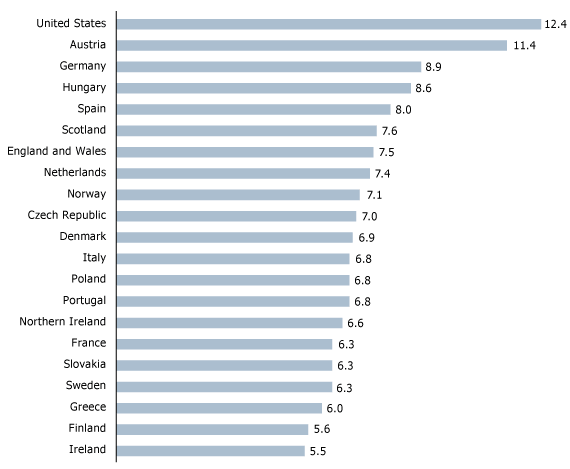
Premature Births Help Explain Higher U.S. Infant Mortality Rate
Date
December 15, 2009
Author
(December 2009) The United States—one of the world’s wealthiest countries—consistently has higher infant mortality rates than most other developed countries. In 2005, 29 countries had lower rates, including Cuba and Poland.1 The United States has seen little improvement in its infant mortality rate since 2000. In 2007, 6.8 of every 1,000 U.S. babies died before their first birthday, not much better than the 6.9 per 1,000 rate in 2000.2 In comparison, the lowest rates, in Singapore, Sweden, and Japan for example, are below 2.6.
A new report from the U.S. National Center for Health Statistics finds that a higher rate of premature births in the United States is the main reason for this poor ranking on infant mortality.3 In 2004, one in eight U.S. births (12.4 percent) were preterm—born before 37 weeks of gestation—much higher than recorded in most European countries, and double the proportion in Ireland, Finland, and Greece (see figure). Most fully developed babies are born at 37 to 42 weeks of gestation.
Percentage of Premature Births Higher in the United States Than in Europe, 2004

Note: Includes births of 22 to 36 weeks gestation. Earlier births were excluded to make the figures more comparable.
Source: Marian F. MacDorman and T.J. Mathews, “Behind International Rankings of Infant Mortality: How the United States Compares With Europe,” NCHS Data Brief, no. 23 (2009): figure 3.
Preterm babies have a higher risk of complications that could lead to death within the first year of life. Their lungs and digestive systems are often not fully developed, and they face a higher risk of brain damage.4 In the United States, more than one-third of infant deaths are related to a premature birth.5
The percentage of U.S. births delivered prematurely rose more than 20 percent between 1990 and 2006. This rise has been tied to several interrelated trends, including an increase in multiple births, greater reliance on Caesarean deliveries and induced labor to manage risky pregnancies, and an increase in births to older mothers. Other maternal factors are also associated with premature births, including behavioral and socioeconomic characteristics such as smoking, teenage pregnancy, obesity, poverty, and inadequate prenatal care.6
There is a racial gap in the percentage of premature births in the United States, linked to the persistent disparity in infant mortality among African Americans and whites.7 In 2006, nearly one in five African American babies was born prematurely, compared with one in eight non-Hispanic white babies. African American mothers tend to have many of the socioeconomic characteristics that have been linked to premature births. African American babies die at twice the rate of white babies.
But racial disparities do not fully explain the poor U.S. ranking in infant mortality. Non-Hispanic white Americans still have higher rates than the average in many developed countries. And the preterm rate has increased fastest for white mothers, who tend to be older and more likely to use infertility treatments than minority women—factors that raise the likelihood of multiple births.
The National Center for Health Statistics study found that the U.S. health care system does a good job of saving premature babies—better than in many European countries—but there are too many of them born. Preventing preterm births is crucial to lowering the U.S. infant mortality rate.
Mary Mederios Kent is senior demographic editor at the Population Reference Bureau.
References
- Marian F. MacDorman and T.J. Mathews, “Behind International Rankings of Infant Mortality: How the United States Compares With Europe,” NCHS Data Brief, no. 23 (2009).
- Jiaquan Xu, Kenneth D. Kochaneck, and Betzaida Tejada-Vera, “Deaths: Preliminary Data for 2007,” National Vital Statistics Reports 58, no. 1 (2009): 6.
- MacDorman and Mathews, “Behind International Rankings of Infant Mortality.”
- The March of Dimes, “Preterm Labor and Birth: A Serious Complication,” accessed online at www.marchofdimes.com/pnhec/188_1080.asp, on Dec. 10, 2009.
- Joyce A Martin et al., “Births: Final Data for 2006,” National Vital Statistics Reports 57, no. 7 (2009): 17-18.
- March of Dimes, “Preterm Labor and Birth”; and Melonie Heron et al., “Deaths: Final Data for 2006,” National Vital Statistics Reports 57, no. 14 (2009): table D.
- Martin et al., “Births: Final Data for 2006”: 18; and Rogelio Saenz, “The Growing Color Divide in U.S. Infant Mortality,” accessed online on Dec. 10, 2009.






